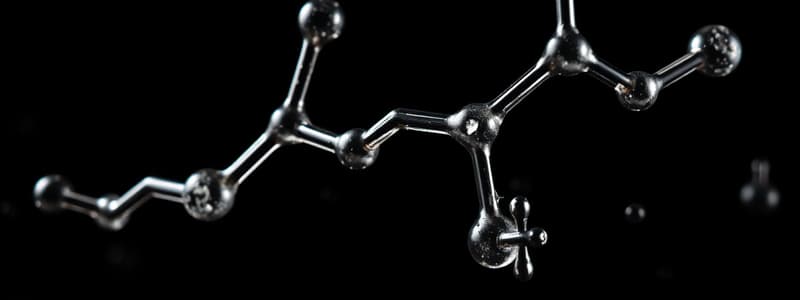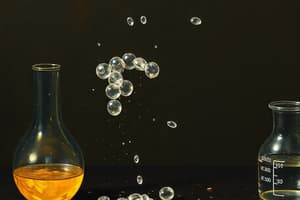Podcast
Questions and Answers
What is the primary product of the reaction involving RX and Zn in the mechanism?
What is the primary product of the reaction involving RX and Zn in the mechanism?
- R-R! (correct)
- R2Zn
- RXZ
- ZnR!
In the mechanism involving hydrohalogenation, which of the following is produced as a byproduct?
In the mechanism involving hydrohalogenation, which of the following is produced as a byproduct?
- NaX
- H2O
- ZnX2
- H-X (correct)
What type of reaction is indicated by the transformation from RX + Zn to the product?
What type of reaction is indicated by the transformation from RX + Zn to the product?
- Metal-catalyzed coupling (correct)
- Electrophilic substitution
- Nucleophilic substitution
- Radical polymerization
Which reagent is typically used in hydroxyestertification within the mechanism described?
Which reagent is typically used in hydroxyestertification within the mechanism described?
What is the role of Zn in the described mechanism?
What is the role of Zn in the described mechanism?
What reagent is commonly used in the reaction involving alkynes with ammoniacal cuprous chloride?
What reagent is commonly used in the reaction involving alkynes with ammoniacal cuprous chloride?
In the reaction of an alkyne with sodium hydroxide, what is produced?
In the reaction of an alkyne with sodium hydroxide, what is produced?
Which of the following indicates a successful reaction with Tollens' reagent?
Which of the following indicates a successful reaction with Tollens' reagent?
What is the primary function of Tollens' reagent in organic reactions?
What is the primary function of Tollens' reagent in organic reactions?
Which compound is likely formed when an alkyne reacts with H2 in the presence of a catalyst?
Which compound is likely formed when an alkyne reacts with H2 in the presence of a catalyst?
What is a possible byproduct when alkynes undergo oxidation reactions?
What is a possible byproduct when alkynes undergo oxidation reactions?
When reacting alkynes with sodium, what is the expected product?
When reacting alkynes with sodium, what is the expected product?
In a reaction where an alkyne undergoes hydration, which improved product is formed?
In a reaction where an alkyne undergoes hydration, which improved product is formed?
What is the process of introducing a sulfonyl group into an alkene called?
What is the process of introducing a sulfonyl group into an alkene called?
Which compound is commonly used in the sulphonation of alkenes?
Which compound is commonly used in the sulphonation of alkenes?
What type of compounds are primarily formed through the sulphonation of alkenes?
What type of compounds are primarily formed through the sulphonation of alkenes?
At what temperature is sulphonation of alkenes typically performed?
At what temperature is sulphonation of alkenes typically performed?
Which of the following reactions would NOT typically involve sulphonation?
Which of the following reactions would NOT typically involve sulphonation?
What is the main function of a sulfonyl group introduced in sulphonation?
What is the main function of a sulfonyl group introduced in sulphonation?
Which mechanism primarily governs the sulphonation of aromatic compounds?
Which mechanism primarily governs the sulphonation of aromatic compounds?
What type of product is typically obtained from the sulphonation of aromatic compounds?
What type of product is typically obtained from the sulphonation of aromatic compounds?
Flashcards are hidden until you start studying
Study Notes
Alkynes Reactions and Reagents
- Tollens' reagent can be used with alkynes for oxidation reactions.
- Reaction involves silver nitrate (AgNO₃) and results in the formation of acetylene and intermediate products.
- The alkynes can undergo reduction via ammoniacal cuprous chloride, yielding alkene derivatives.
Additional Reaction Mechanisms
- Generic reaction: R-C≡C-H + NaOH → R-C≡C-OH + H₂O, showcasing how alkynes can be converted into hydroxylated compounds.
- Another transformation includes: A-C≡C-H → A-C(OH)-C-R, indicating conversion of terminal alkynes to alcohols.
Named Reactions
- Friedel-Crafts reaction: involves the acylation of aromatic compounds with alkyl halides.
- Mechanism: requires zinc to facilitate the reaction which helps in the halogenation and subsequent substitution by nucleophiles.
- Hydrolysis step typically involving water (H₂O) leading to synthesis of alcohols from alkyl halides.
Alkenes and Alkynes
- Sulphonation of alkenes at high temperatures can yield sulfonic acids.
- Tetramerization process refers to the reaction that extends the carbon chain of alkynes to form longer carbon compounds.
General Concepts
- Understanding the behavior of alkynes under various reagents is crucial for their application in synthesis.
- The use of specific conditions and catalysts can significantly alter the course of reactions involving hydrocarbons.
Studying That Suits You
Use AI to generate personalized quizzes and flashcards to suit your learning preferences.




